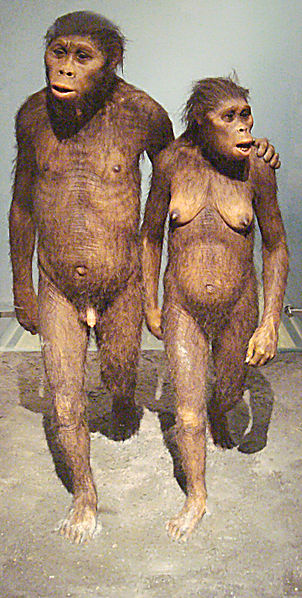Leisure TimeThe average man in London would have worked more than 100 hours a week and lived in dark, miserable times marred by plague and famine. Nevertheless, the inhabitants of the city appeared to live busy social lives and entertained themselves with many crude activities.
Object Title: Object Title: Ladies’ flavoured maskC. C.2005 ADRubber
London’s air in the early 21st century was toxic with pollution and infectious disease. Many people wore masks on their lower faces while going on a bracing walk. This mask was flexible for the wearers and scented with a pleasing aroma to ensure the comfort of the woman who would have worn it. There would have been strings on the side of this mask to attach it behind her ears.
-
Used as barrier protection from STIs during oral sex on a vulva.
Object Title: Training Equipment C.2095 AD
Metal and acrylic
This miniaturised metal implement was used to twist the plastic skein and symbolically re-enact Man’s farming prowess. The act of knotting and manipulating the yarn to produce a ritual pattern was a highly dexterous art which only could have been undertaken by a man. The man of the house would work for hours at a time on his complex formations.-
Download a pattern to crochet your very own clitoris!
Object Title: Dried Flowers C. 2175 AD
Organic material
A popular pastime in London was flower arranging. This activity involved hunting flowers, killing the best specimens, using sharp blades to contort and disfigure the flowers into the desired shape, then forcing them into a configuration that showcased the skill of the hunter. The aggressive qualities and looming reminder of death involved in flower arranging meant that it was a male-dominated field that women would struggle to excel in.
-
For making pleasing floral displays.
Gender RolesThe patriarchy likes to pretend that modern gender roles are biological because that would mean they can’t change and the status quo can persist.
This idea is reinforced by applying patriarchal values inappropriately throughout history and science. Sometimes it is purposeful: insisting on the biological truth of gender roles using evidence that wouldn’t be considered strong enough for other theories; and sometimes it is subtle and only noticeable once pointed out.
Women are inherently weak
17 year old Jackie Mitchell was a promising rising star in baseball. In her debut game for the Chattanooga Lookouts on 2nd April 1931, Mitchell struck out two of the greatest baseball players of all time: Babe Ruth and Lou Gehrig. Ruth sulked and told the local paper:
“I don’t know what’s going to happen if they begin to let women in baseball. Of course they will never make good. Why? Because they are too delicate. It would kill them to play ball every day.”
Mitchell’s contract was voided by the Commissioner of Baseball, Kenesaw Mountain Landis, who said the game was “too strenuous” for women to play.
Julie Mitchell, pitching in 1931
New York World - Telegram and The Sun newspaper
Grave Goods
In the early 2010s, a study of 664 burials in Sweden between 700 - 1100 AD to learn more about life in the Viking Age uncovered that one of the people buried in Birka, individual Bj 581, was not male as presumed.
Grave Bj 581 had inside a number of weapons and the archaeologists who uncovered it in 1878 immediately assumed since the grave goods showed they were a warrior, the skeleton must be a cis-man. A genetic study confirmed there was no trace of a Y chromosome in the skeleton, the section of DNA that leads to the body making a penis and testes rather than a uterus and vulva.
When the results were published, people accused them of mixing up their samples or ignoring an apparently undiscovered second skeleton. The resistance to the rereading of Norse archaeology likely stemmed from the fact that if this was true, every grave would now need to be reassessed and the narrative of the hyper-masculinised, patriarchal Viking culture is wrong. This resistance is somewhat surprising considering the wealth of Norse mythology around female warriors such as the Valkyries.
Illustration by Evald Hansen based on the original plan of grave BJ581 by excavator Hjalmar Stolpe,published 1889
In the American Museum of Natural History’s Spitzer Hall of Human Origins, there are life size models of two Australopithecus figures who are thought to have left footprints found in Laetoli, Tanzania roughly 3-4 million years ago.
The pose of the male and female is clearly gendered, even though we know next to nothing for definite about gender relations of hominids in this time period.
Models of a male and female Australopithecus that may have made the 3-4 million year old footprints found in Laetoli, Tanzania. Part of the American Museum of Natural History’s Spitzer Hall of Human Origins.







